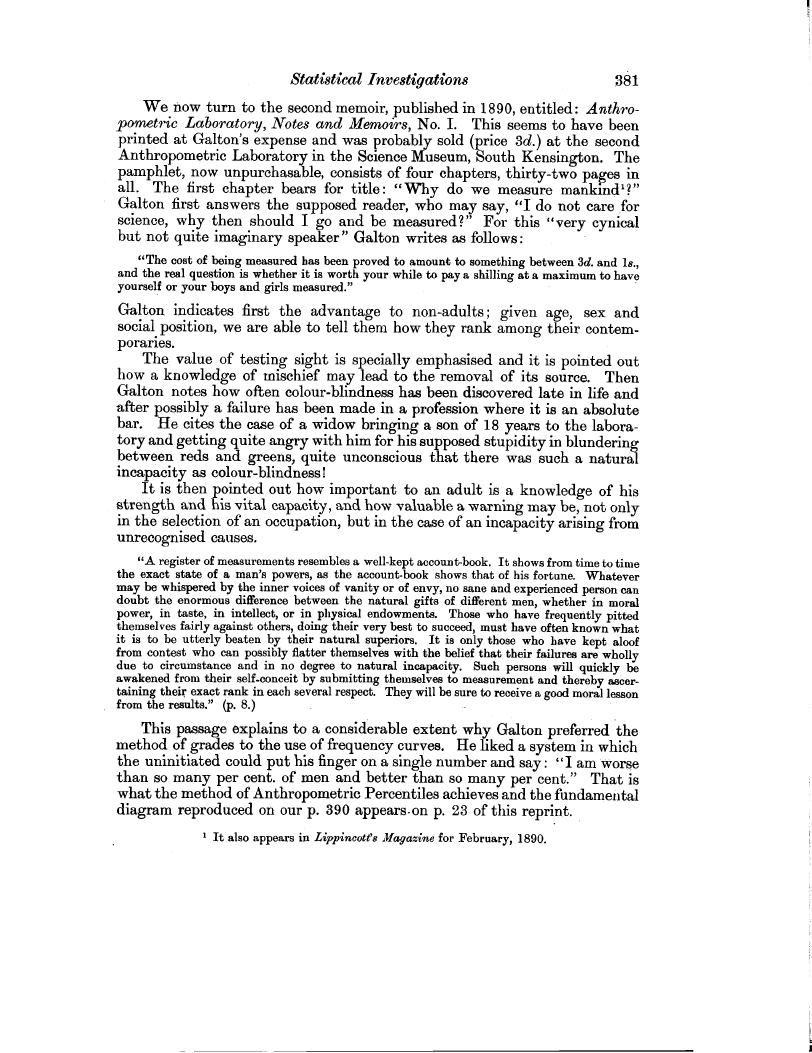Statistical Investigations 381
We now turn to the second memoir, published in 1890, entitled: Anthropometric Laboratory, Notes and Memoirs, No. I. This seems to have been printed at Galton's expense and was probably sold (price 3d.) at the second Anthropometric Laboratory in the Science Museum, South Kensington. The pamphlet, now unpurchasable, consists of four chapters, thirty-two pages in all. The first chapter bears for title: "Why do we measure mankind'?" Galton first answers the supposed reader, who may say, "I do not care for science, why then should I go and be measured?" For this "very cynical but not quite imaginary speaker" Galton writes as follows:
"The cost of being measured has been proved to amount to something between 3d. and 18., and the real question is whether it is worth your while to pay a shilling at a maximum to have yourself or your boys and girls measured."
Galton indicates first the advantage to non-adults ; given age, sex and social position, we are able to tell them how they rank among their contemporaries.
The value of testing sight is specially emphasised and it is pointed out how a knowledge of mischief may lead to the removal of its source. Then Galton notes how often colour-blindness has been discovered late in life and after possibly a failure has been made in a profession where it is an absolute bar. He cites the case of a widow bringing a son of 18 years to the laboratory and getting quite angry with him for his- supposed stupidity in blundering between reds and greens, quite unconscious that there was such a natural incapacity as colour-blindness
It is then pointed out how important to an adult is a knowledge of his strength and his vital capacity, and how valuable a warning may be, not only in the selection of an occupation, but in the case of an incapacity arising from unrecognised causes.
"A register of measurements resembles a well-kept account-book. It shows from time to time the exact state of a man's powers, as the account-book shows that of his fortune. Whatever may be whispered by the inner voices of vanity or of envy, no sane and experienced person can
doubt the enormous difference between the natural gifts of different men, whether in moral power, in taste, in intellect, or in physical endowments. Those who have frequently pitted themselves fairly against others, doing their very best to succeed, must have often known what it is to be utterly beaten by their natural superiors. It is only those who have kept aloof from contest who can possibly flatter themselves with the belief that their failures are wholly due to circumstance and in no degree to natural incapacity. Such persons will quickly be awakened from their self-conceit by submitting themselves to measurement and thereby ascertaining their exact rank in each several respect. They will be sure to receive a good moral lesson from the results." (p. 8.)
This passage explains to a considerable extent why Galton preferred the method of grades to the use of frequency curves. He liked a system in which the uninitiated could put his finger on a single number and say : "I am worse than so many per cent. of men and better than so many per cent." That is what the method of Anthropometric Percentiles achieves and the fundamental diagram reproduced on our p. 390 appears-on p. 23 of this reprint.
1 It also appears in Lippincott's Magazine for February, 1890.

